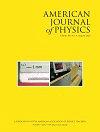用于研究多模光干涉的纤维内马赫-泽恩德应变传感器
IF 0.8
4区 教育学
Q3 EDUCATION, SCIENTIFIC DISCIPLINES
引用次数: 0
摘要
光的多模干涉是一种基于波导的光干涉现象,在光通信、激光和光纤传感领域有着广泛的应用。由于光纤已成为现代社会应用最广泛的光波导,因此光纤中的多模干涉是大学教学实验室项目的理想候选。在此,我们采用基于马赫-泽恩德应变传感器的光纤内实验来研究光纤中的多模干扰。传感器的制作方法是在两根单模光纤之间熔接一段细芯光纤。薄芯光纤的一端是在没有纤芯偏移的情况下熔接的,而另一端是在有纤芯偏移的情况下熔接的。由于模场直径不匹配和纤芯偏移,包层模式被激发并干扰薄芯光纤中的纤芯模式。学生可以观看传感器制作演示,并使用光学频谱分析仪进行应变测试。利用快速傅里叶变换和快速傅里叶变换滤波器等信号处理工具,分析光学频谱分析仪在不同应变下捕获的波长光谱。然后,学生们通过分析找到传感器中多模干扰的特征。该实验拓展了本科生对光干涉的认识,对他们学习现代相干理论具有指导意义。本文章由计算机程序翻译,如有差异,请以英文原文为准。
An in-fiber Mach–Zehnder strain sensor for studying multimode interference of light
Multimode interference of light is an optical interference phenomenon based on waveguides, which has broad applications in optical communication, lasers, and optical fiber sensing. Since optical fiber has become the most widely used optical waveguide in modern society, multimode interference in optical fibers is an ideal candidate for projects in university teaching laboratories. Here, we implement an in-fiber Mach–Zehnder strain sensor-based experiment to study multimode interference in optical fibers. The sensor is fabricated by fusion splicing a piece of thin core fiber between two single mode fibers. One end of the thin core fiber is spliced without a core offset, while the other end is spliced with a core offset. Due to the mode field diameter mismatch and core offset, cladding modes are excited and interfere with the core mode in thin core fiber. Students can observe the sensor fabrication demonstration and perform a strain test with an optical spectrum analyzer. The wavelength spectra captured by the optical spectrum analyzer under different strains are analyzed with the signal processing tools of fast Fourier transform and fast Fourier transform filter. Students then find characteristics of the multimode interference in the sensor from the analysis. The experiment extends undergraduates' knowledge of light interference and is an instructive exercise for them in modern coherence theory.
求助全文
通过发布文献求助,成功后即可免费获取论文全文。
去求助
来源期刊

American Journal of Physics
物理-物理:综合
CiteScore
1.80
自引率
11.10%
发文量
146
审稿时长
3 months
期刊介绍:
The mission of the American Journal of Physics (AJP) is to publish articles on the educational and cultural aspects of physics that are useful, interesting, and accessible to a diverse audience of physics students, educators, and researchers. Our audience generally reads outside their specialties to broaden their understanding of physics and to expand and enhance their pedagogical toolkits at the undergraduate and graduate levels.
 求助内容:
求助内容: 应助结果提醒方式:
应助结果提醒方式:


